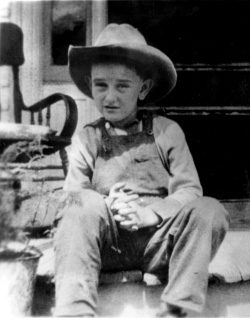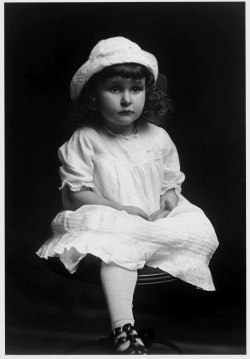Timeline: LBJ and the Nation
1908-1919 1920-1929 1929-1940 1941-1945 1946-1953 1954-1960 1960-1963 1963-1969 1969-1973
1908-1919
The United States was changing as it entered the second decade of the new century. The marvel of radio was uniting all its hamlets and cities as even the great transcontinental railroad could not. The companion marvel of the motion picture brought its magic to all parts of the country.
The syncopated rhythm of ragtime replaced the stately waltz. The assembly line began the transformation of industrial life. Traditionally isolationist, America initially stayed aloof when war engulfed Europe, but in 1917, the U.S. joined forces with the allies against the German Empire. An armistice in November 1918 ended the "Great War," later called World War I, that killed 8,500,000, including 53,402 Americans.
In the hill country of central Texas, Lyndon Baines Johnson was born in 1908 to Sam Ealy and Rebekah Baines Johnson. Claudia (“Lady Bird”) Johnson was born in 1912 to T.J. and Minnie Taylor, living in East Texas.
Events
- After its move westward across the continent and its acquisition of the Philippines, Hawaii, and Guam, the U.S. was part of the Pacific Ocean world as well as the Atlantic. The Great White Fleet, naval vessels dispatched by President Theodore Roosevelt to demonstrate American interest and strength in the Pacific, headed for home in 1908.
- Also in 1908, William Howard Taft succeeded Roosevelt as president and was the first chief executive to throw out a baseball in a major league game.
- The first Model T Ford rolled off the newly developed assembly line, a revolutionary process that cut the cost of manufacturing sufficiently to make the automobile affordable for the average family.
- Thomas Alva Edison, who gave the world the phonograph and the incandescent lamp with carbon filament, and was a pioneer in motion pictures, developed the forerunner of talking films.
- Woodrow Wilson, Governor of New Jersey, was elected president in 1912.
- On April 14-15, 1912, the Titanic sank.
- Women, who had been demanding the right to vote for sixty-five years, demonstrated in Washington, D.C., in 1913. Their efforts bore fruit in the Nineteenth Amendment to the Constitution, which was ratified in 1920.
- In 1916, war in Europe was still of only remote concern to most Americans. Closer to U.S. interests was the Army's campaign led by General John J. Pershing to halt raids against U.S. property in the Southwest by the Mexican revolutionary Francisco ("Pancho") Villa.
- A British ocean liner, the Lusitania, set out on the fateful voyage in which it was sunk by German torpedoes, with 128 Americans losing their lives, signaling Germany's warfare against merchant shipping and igniting the war fever that ultimately brought the U.S. into World War I.
- Preparing for combat, Army ranks were filled by a draft lottery held in Washington, D.C., on July 20, 1917. Draft boards nationwide assigned numbers to local registrants; during the lottery the numbers were drawn in random order by a blindfolded individual. All across the countrymen who shared the same number were drafted at the same time according to the order in which it was drawn.
- American troops under Pershing began manning the trenches in France in the summer of 1918, and, through an autumn of fierce combat, the tide of war began to turn. An armistice brought an end to the fighting in November 1918. A total of 8,500,000, including 53,402 Americans, were killed in the war; even more were wounded or lost to influenza.
Lyndon Baines Johnson
A farmhouse on the banks of the Pedernales River was the home of Sam Ealy Johnson, Jr., a farmer and populist politician who served twelve years in the Texas legislature, and his wife, Rebekah Baines, who came from a genteel youth in the towns of Blanco and Fredericksburg.
In this hard scrabble hill country of Central Texas, sixty-five miles west of Austin, the major event of 1908 to Sam Ealy and Rebekah Baines Johnson was the birth on August 27, of their first child, a boy they named Lyndon after a family friend. The boy's grandfather predicted: "I expect him to be a United States senator before he is forty." When Lyndon was five years old, the family moved to a six-room frame house in Johnson City (population two hundred).
Lady Bird Johnson
Three hundred and fifty miles east of the hill country, in the town of Karnack deep in the piney woods of East Texas, a girl was born in 1912 to a well-to-do storekeeper and property owner named T. J. Taylor and his wife, Minnie. The child was named Claudia, but "Pretty as a lady bird," was the way the little girl's nurse described her and the name stuck for life.
At three-years-old Lady Bird remembered her mother only dimly. Her Aunt Effie, whom she later described as "one of those gentle creatures not meant for this world, practically," had a great effect on her. Nonetheless, she recalled late in life, "I grew up rather alone."


